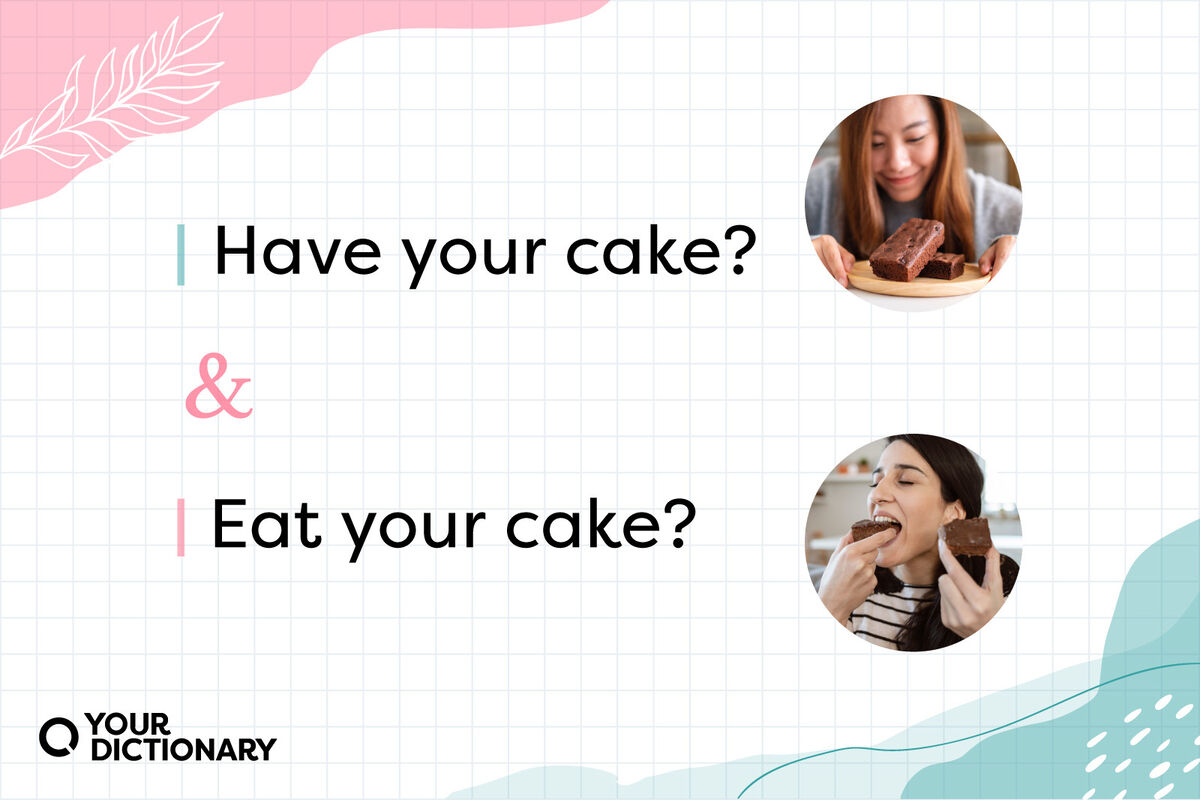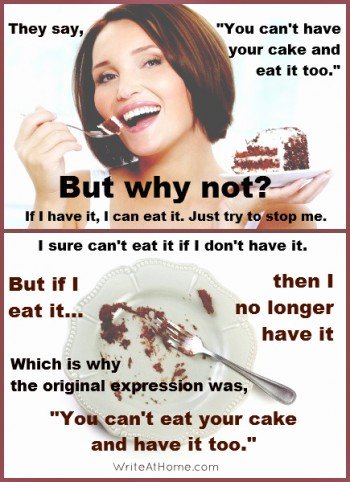Can’t Have Your Cake And Eat It Too Example: Life’s Balancing Act
The phrase “You can’t have your cake and eat it too” means you can’t enjoy two conflicting benefits at the same time. An example is wanting to save money while also spending lavishly.
The saying reflects a universal truth about choices and sacrifices. Life often presents situations where you must make tough decisions. For instance, you might wish to travel extensively while maintaining a stable job. Each choice comes with its own benefits and drawbacks.
Accepting this reality can lead to a more fulfilled life. Understanding the implications of our choices helps in prioritizing what truly matters. This phrase serves as a reminder that to gain something valuable, you often have to give something up. Embracing this mindset can lead to better decision-making.

The Origins Of ‘can’t Have Your Cake And Eat It Too’
The phrase ‘Can’t Have Your Cake and Eat It Too’ conveys a simple truth. You cannot enjoy two conflicting things at the same time. This idiom has deep roots and interesting meanings throughout history.
Historical Context
The phrase dates back to at least the 16th century. It appears in various forms in English literature. Early records show variations like:
- “You can’t eat your cake and have it too.”
- “You can’t have your cake and eat it.”
These versions emphasize the same idea: once you eat your cake, it’s gone. The phrase reflects a universal human experience of choice and sacrifice.
Historically, cakes represented luxury and wealth. In earlier times, having a cake was a sign of abundance. The phrase highlights the importance of making choices in life.
Modern Interpretations
Today, ‘Can’t Have Your Cake and Eat It Too’ applies in various contexts. It is often used in discussions about relationships, finance, and career choices. People face decisions that require compromises.
Examples of modern interpretations include:
- Choosing between career advancement and personal life.
- Deciding on financial investments versus immediate spending.
- Maintaining friendships while pursuing romantic interests.
In each scenario, the phrase serves as a reminder. Life demands choices, and often, sacrifices. Understanding this helps navigate complex situations.
Overall, the origins of this idiom reveal its timeless wisdom. The struggle to balance desires remains relevant today.

Life’s Balancing Act: Personal Life
Balancing personal life can be tricky. Everyone wants happiness at home and work. This balance is essential for well-being. You can’t have everything without making some sacrifices.
Work-life Harmony
Finding harmony between work and home is vital. Here are some tips for achieving this balance:
- Set clear work hours.
- Prioritize tasks effectively.
- Communicate openly with your employer.
- Take breaks to recharge.
- Practice mindfulness during downtime.
Work-life harmony leads to better productivity. Happy workers are more engaged. A balanced life reduces stress and improves health.
Family Vs. Personal Time
Personal time is as important as family time. Both need attention to flourish. Here’s how to manage both:
- Schedule family activities.
- Set aside “me time” each week.
- Encourage family support for personal goals.
- Limit distractions during family time.
- Share responsibilities at home.
Balancing family and personal time can be rewarding. Happy families create strong bonds. Self-care leads to better relationships.
| Aspect | Importance |
|---|---|
| Work-Life Harmony | Boosts productivity and reduces stress |
| Family Time | Strengthens relationships and builds memories |
| Personal Time | Encourages self-growth and relaxation |
Finding the right balance is a continuous journey. Make adjustments as life changes. Remember, you can’t have your cake and eat it too.
Career Ambitions And Personal Sacrifice
Balancing career ambitions with personal life can be tough. Many individuals face difficult choices. They often want to succeed but must sacrifice personal time and relationships. This struggle highlights the saying, “Can’t have your cake and eat it too.”
Climbing The Corporate Ladder
Climbing the corporate ladder means hard work and dedication. Many people put in long hours. They attend meetings, work overtime, and take on extra projects.
- Promotion opportunities require commitment.
- Networking is essential for career growth.
- Skill development is crucial for advancement.
As professionals rise in their careers, personal life often takes a back seat. Family events get missed. Friendships may fade away. Achieving high positions can come at a cost.
Cost Of Professional Success
The cost of professional success includes various sacrifices. These can affect mental and physical health.
| Type of Sacrifice | Impact |
|---|---|
| Time with Family | Weakened relationships and missed milestones |
| Personal Hobbies | Lack of fulfillment and increased stress |
| Health | Burnout and fatigue |
Finding balance is essential. People must assess their priorities. Understanding what to sacrifice is key to happiness.
Financial Decisions: Saving Versus Spending
Making financial decisions is tricky. You often face the dilemma of saving money or spending it. This choice affects your future goals and current lifestyle. Balancing these two can feel impossible.
Budgeting Challenges
Budgeting is essential for managing finances. Many people struggle with it. Here are some common challenges:
- Tracking daily expenses
- Setting realistic goals
- Staying disciplined
Budgeting requires effort and commitment. It’s important to create a plan and stick to it. A well-structured budget helps you save money over time.
Long-term Vs. Short-term Gratification
Deciding between long-term and short-term gratification is crucial. Long-term gratification means saving for the future. Short-term gratification focuses on enjoying your money now. Here’s a simple comparison:
| Type | Definition | Example |
|---|---|---|
| Long-Term Gratification | Saving for future needs | Investing in a retirement fund |
| Short-Term Gratification | Spending money immediately | Buying a new gadget |
Understanding these concepts helps in making better choices. Consider these questions:
- What are my long-term goals?
- Can I afford to wait for rewards?
Finding the right balance is key. Prioritize your needs and wants wisely.
Health And Well-being: Indulgence Vs. Discipline
Balancing health and indulgence can be tricky. Many people want to enjoy treats while staying fit. Understanding this balance helps achieve overall well-being. Here, we explore dietary choices and lifestyle habits.
Dietary Choices
Making wise dietary choices is essential. Food impacts our body and mind. Here are some tips:
- Choose whole foods over processed options.
- Limit sugar and saturated fats.
- Incorporate fruits and vegetables daily.
- Practice portion control during meals.
Consider the following table for a better understanding:
| Food Type | Healthy Option | Less Healthy Option |
|---|---|---|
| Snack | Fruit | Chips |
| Beverage | Water | Soda |
| Breakfast | Oatmeal | Doughnut |
Exercise And Lifestyle
Regular exercise is vital for health. It boosts mood and energy. Find an activity you enjoy. Here are some popular options:
- Walking or jogging
- Cycling
- Yoga or Pilates
- Team sports
Creating a consistent routine is key. Aim for at least 30 minutes daily. Combine exercise with healthy eating for best results. Remember, small changes lead to big improvements.
Social Dynamics: Fomo And Choosing Priorities
Social dynamics often revolve around FOMO—the fear of missing out. People face pressure to attend every event. This creates a conflict between social commitments and personal time. Understanding how to balance these priorities is essential.
Navigating Friendships
Friendships require attention and effort. Sometimes, it feels like you must choose between friends. This can lead to feelings of guilt or exclusion. Here are some tips to navigate friendships effectively:
- Communicate openly: Share your feelings and limitations.
- Set boundaries: Know when to say no.
- Prioritize quality: Focus on meaningful interactions.
- Balance your time: Allocate time for friends and self.
Social Commitments And Personal Time
Balancing social commitments with personal time is crucial. Overcommitting can lead to stress and burnout. Here’s how to manage your time better:
| Social Commitment | Personal Time Activity |
|---|---|
| Weekly hangouts | Reading or hobbies |
| Group outings | Relaxing with a movie |
| Birthday parties | Self-care routines |
Making choices is part of life. Recognize your limits. Choose what makes you happy. Prioritize your well-being over societal expectations. Find a balance that works for you.
Education And Opportunities: The Trade-offs
Choosing education often involves tough choices. Many people want the best of both worlds. They desire higher education while also wanting to earn money. This section explores these trade-offs. It highlights the importance of making informed decisions.
Pursuing Higher Education
Pursuing higher education can open doors. It leads to better job opportunities and higher salaries. Yet, this path requires time and money. Students often face the dilemma of time versus money.
- Time Investment: Most degrees take 2 to 4 years.
- Financial Costs: Tuition fees can be high.
- Opportunity for Experience: Less work experience during studies.
Many students work part-time. Balancing work and studies can be difficult. Stress and fatigue may occur. Some choose to study full-time. This decision means missing out on early job experiences.
Opportunity Costs Involved
Opportunity cost is the value of what you give up. Choosing higher education often means sacrificing immediate income. This table shows the potential trade-offs:
| Option | Pros | Cons |
|---|---|---|
| Full-Time Study |
|
|
| Part-Time Work |
|
|
Each choice has its pros and cons. Understanding these can help in decision-making. Think carefully about what matters most to you.
Cultural Expectations And Individual Desires
Cultural expectations often clash with individual desires. Many people feel torn between what society wants and what they truly want. This conflict can lead to stress and confusion. Understanding this struggle is important for personal growth.
Traditional Roles Vs. Personal Goals
Traditional roles shape our lives in many ways. They dictate how we should behave and what we should achieve.
- Women may feel pressure to be caregivers.
- Men may feel they must be the primary earners.
These roles can limit personal goals. People often sacrifice their dreams for societal approval.
Finding a balance is crucial. Here are some steps to consider:
- Identify your true passions.
- Evaluate societal expectations.
- Set clear personal goals.
- Seek support from like-minded individuals.
Societal Pressure And Self-fulfillment
Societal pressure can feel overwhelming. It can stop you from pursuing what makes you happy.
| Societal Pressure | Effects on Self-Fulfillment |
|---|---|
| Expectations to conform | Reduces self-esteem |
| Fear of judgment | Stifles creativity |
| Need for approval | Delays personal growth |
Breaking free from societal pressure is essential. Focus on what brings you joy. Embrace your unique path. Self-fulfillment comes from within.
Finding Equilibrium: Strategies For Balance
Striking a balance in life is essential. Many people desire multiple things at once. The saying “You can’t have your cake and eat it too” reminds us of this challenge. Here are effective strategies to help find that balance.
Setting Boundaries
Boundaries help define what is acceptable. They protect your time and energy. Here are some tips:
- Know your limits: Understand what you can handle.
- Communicate clearly: Let others know your boundaries.
- Say no: It’s okay to decline requests.
- Prioritize tasks: Focus on what truly matters.
Use a planner to organize your time. Schedule breaks to recharge. Setting boundaries leads to less stress and more focus.
Mindfulness And Reflection
Mindfulness helps you stay present. It allows for better decision-making. Consider these practices:
- Daily meditation: Spend a few minutes in silence.
- Journaling: Write down your thoughts and feelings.
- Gratitude practice: List things you are thankful for.
- Check-in with yourself: Assess your feelings regularly.
Mindfulness creates awareness. It helps you recognize when you are off balance. This awareness enables better choices.
Real-life Scenarios: Case Studies
Understanding the phrase “Can’t have your cake and eat it too” becomes clearer through real-life examples. These scenarios illustrate how choices come with trade-offs. The consequences of decisions often lead to unexpected outcomes.
Professional Dilemmas
In the workplace, individuals face tough choices. Balancing career growth and personal time can be challenging. Here are two case studies:
- Case Study 1: The Overworked Employee
Jane wants a promotion. She works late nights and weekends. Her boss notices her dedication. However, Jane misses family events. She feels guilty and stressed. She can’t enjoy her success fully.
- Case Study 2: The Entrepreneur
Mark starts a business. He dreams of financial freedom. He invests all his savings. He works tirelessly. Yet, he sacrifices a stable paycheck. Mark faces uncertainty and stress. He can’t enjoy both security and ambition.
Personal Choices And Consequences
Personal life also reflects this dilemma. People often choose between different desires. Here are two notable examples:
- Example 1: The Social Butterfly
Emily loves to party. She enjoys meeting friends and having fun. However, she neglects her studies. Her grades drop significantly. She realizes she can’t maintain both a vibrant social life and academic success.
- Example 2: The Fitness Journey
Tom aims for a healthy lifestyle. He wants to eat junk food and stay fit. He finds it hard to resist pizza and soda. Tom learns he can’t indulge in treats and achieve fitness goals.
These examples highlight the universal truth of choices. Everyone faces trade-offs in both personal and professional life. Understanding this can lead to better decision-making.

Frequently Asked Questions
What Does “can’t Have Your Cake And Eat It Too” Mean?
This phrase means you cannot enjoy two mutually exclusive benefits. It highlights the reality that certain choices require sacrifices. Essentially, you cannot keep your cake and eat it simultaneously; once you eat it, it’s gone. It serves as a reminder of the limitations in decision-making.
How Can I Use This Phrase In Conversation?
You can use this phrase when discussing choices or compromises. For instance, say it when a friend wants to enjoy both an expensive vacation and save money. It helps convey the idea that one option may exclude the other. It’s a handy expression for emphasizing the need for priorities.
What Are Some Examples Of This Phrase In Action?
Consider a scenario where someone wants to excel at work while also enjoying a lavish lifestyle. This situation illustrates the phrase perfectly. Another example is wanting to maintain friendships while pursuing a demanding career. Both examples show the inherent conflicts in our desires and choices.
Is This Phrase Commonly Used In English?
Yes, this phrase is quite popular in English-speaking cultures. It often appears in discussions about life choices and priorities. Many people use it to illustrate the impossibility of having it all. It’s a relatable expression that resonates with various life situations.
Conclusion
Balancing desires can be challenging. The phrase “can’t have your cake and eat it too” reminds us of the limits we face. Embracing trade-offs is essential for personal growth. Understanding this concept helps us make wiser choices in life. Ultimately, it encourages us to prioritize what truly matters.




